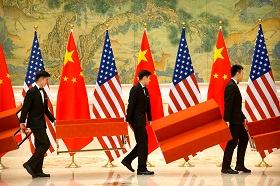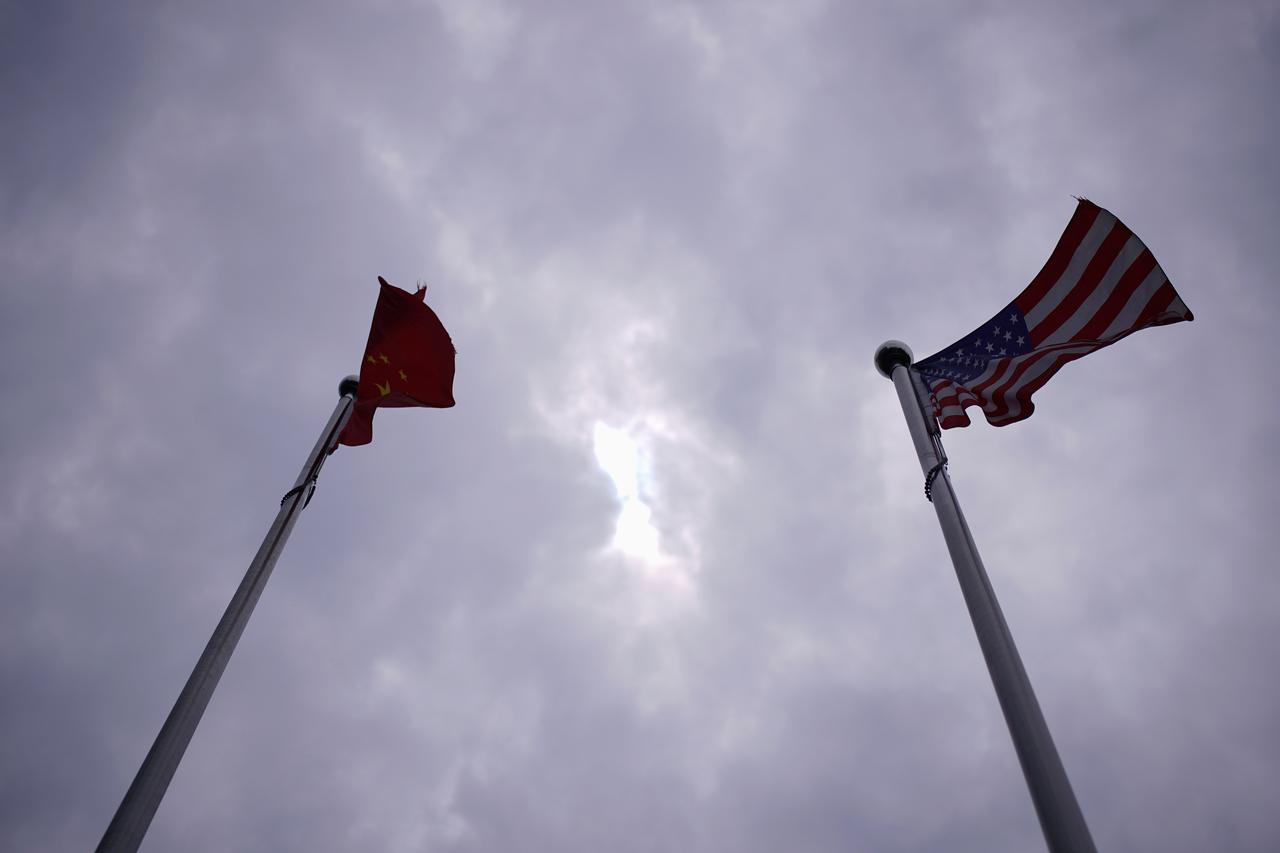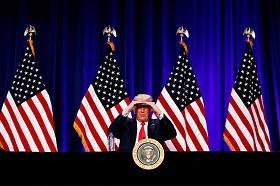Bipolarity and its Relations with Multipolarity and Unipolarity
(votes: 6, rating: 4.33) |
(6 votes) |
Professor, Fudan University, Beijing Club for International Dialogue, Senior Fellow
For most of the time after the end of the cold war, the contradiction between a unipolar and multipolar world was the main focus of the world structure. But now this state of affairs has been broken. With the emergence of a bipolar theory, relations between multipolarity and unipolarity is no longer the only pattern of the international structure. Bipolarity and its relations with multipolarity and unipolarity has become a new analytical issue with increasing significance.
The bipolar view first emerged about ten years ago, but has gained popularity in recent years. Naturally, by the bipolar world, it refers to China and the United States.
There are no strict definitions and standards for what is “polar,” nor are there strict definitions and standards for the unipolar, bipolar and multipolar patterns. They are mainly a descriptive concept, without absolute quantitative indicators, and have greater relativity in different use environments.
The major arguments for the bipolar view are national strength and economic index. From this perspective, the formation of the bipolar structure has a series of strong supporting elements.
First, China's economic aggregate is close to that of the United States, and the gap between the two economies has been substantially narrowed, making them comparable. In 1980, China's GDP was only 10.7% of that of the U.S., it increased to 23.7% in 2007 and by 2017 it had risen to 62 %.
Second, the economy of China and the United States is far larger than the third largest economy behind them. In terms of the GDP of the major countries in the world, it is now a typical structure of a pyramid. In 2019, America was the only country with a GDP over $20 trillion ($22 trillion). China is the only country with GDP over $10 trillion ($12 trillion), followed by Japan and Germany with $4-6 trillion, and Britain, France, India, Italy, Russia, Canada with $2-3 trillion [1]. According to a Chinese official, China's GDP in 2019 was equivalent to that of Japan, Germany, Britain, France combined in 2018.
The new scientific and technological revolution will have a profound impact on the world. But it has been a technological rather than a political revolution for international politics. A new technology revolution can lead to the rapid change of national strength, can make the world structure reconstructed, can change the shape of military technology and war, and change the way of human life and the course of history. Nonetheless, it does not deny the basic concept of international politics, does not change the fundamental nature of international relations and also won't eliminate the source of confrontation between countries.
The new scientific and technological revolution has not changed the course of China-U.S. relations. Instead of providing new demands for China-U.S. cooperation, it has become an irritant in deepening the deterioration of bilateral relations. In fact, it has itself become an important form and content of contradictions between the two countries.
Fundamentally, it is political relations that determine technological relations. Technological revolution serves political purposes, not technology changes politics, nor does politics submit to technology. This has been true of previous technological revolutions in history. The U.S.-Soviet relationship during the Cold War was also an example. Nuclear weapons and satellite technology were epoch-making military technological revolutions. Their emergence changed the pattern of war and the understanding of war, but they did not change the political nature of U.S.-Soviet relations. Instead, they brought the competition between the two countries to new areas and new heights.
The COVID-19 outbreak in 2020 is a once-in-a-lifetime catastrophe. There has never been an enemy that poses a common threat to all countries and even the entire human race like a novel Coronavirus. When the world and mankind are in catastrophe, China and the United States should have joined hands and cooperated to fight against the epidemic. Contrary to the expectations of the international community and China, the epidemic has not only worsened China-U.S. relations but greatly intensified the polarization between China and the United States. It is reasonable to believe that the trend of bipolarization between China and the United States will continue and deepen even in the post-pandemic period.
For most of the time after the end of the cold war, the contradiction between a unipolar and multipolar world was the main focus of the world structure. But now this state of affairs has been broken. With the emergence of a bipolar theory, relations between multipolarity and unipolarity is no longer the only pattern of the international structure. Bipolarity and its relations with multipolarity and unipolarity has become a new analytical issue with increasing significance.
The bipolar view first emerged about ten years ago, but has gained popularity in recent years. Naturally, by the bipolar world, it refers to China and the United States.
There are no strict definitions and standards for what is “polar,” nor are there strict definitions and standards for the unipolar, bipolar and multipolar patterns. They are mainly a descriptive concept, without absolute quantitative indicators, and have greater relativity in different use environments.
What Supports the Bipolar Theory?
The major arguments for the bipolar view are national strength and economic index. From this perspective, the formation of the bipolar structure has a series of strong supporting elements.
First, China's economic aggregate is close to that of the United States, and the gap between the two economies has been substantially narrowed, making them comparable. In 1980, China's GDP was only 10.7% of that of the U.S., it increased to 23.7% in 2007 and by 2017 it had risen to 62 %.
Second, the economy of China and the United States is far larger than the third largest economy behind them. In terms of the GDP of the major countries in the world, it is now a typical structure of a pyramid. In 2019, America was the only country with a GDP over $20 trillion ($22 trillion). China is the only country with GDP over $10 trillion ($12 trillion), followed by Japan and Germany with $4-6 trillion, and Britain, France, India, Italy, Russia, Canada with $2-3 trillion [2]. According to a Chinese official, China's GDP in 2019 was equivalent to that of Japan, Germany, Britain, France combined in 2018.
Third, the combined economic aggregate of China and the United States accounts for a significant proportion of the world economy and has a decisive influence on it. In 2018 the world's total economic value was about $84 trillion. The United States accounted for about 24 per cent, while China accounted for about 16 per cent. Together, China and the United States account for about 40 per cent of the world economy. In international trade, China's imports and exports amounted to about $4.62 trillion in 2018, accounting for 11.75% of global trade, while the United States was 10.87%. The two countries account for more than a fifth of world trade.
Fourth, in the ongoing new scientific and technological revolution, China and the United States are also leaders. Take artificial intelligence as an example. The numbers of artificial intelligence engineers and enterprises in the U.S. and China rank first and second in the world. As for the number of artificial intelligence patents, China has slightly more than that of the United States [3]. In terms of the digital economy, the proportion of China and the United States in blockchain, internet of things, cloud computing and other fields is much higher than that of the other countries. In 2018, the world's top 10 internet companies were all Chinese and American companies, including 6 from the United States and 4 from China [4].
Fifth, China and the United States maintain the largest and advanced military forces. Militarily Russia is stronger than China on a number of measures, particularly on strategic nuclear weapons, but China and the U.S. are far ahead of the rest in military budget and have the greatest defence potential. According to the Swedish Institute of International Peace, the U.S. spent $732 billion on its military in 2019, China $261 billion, followed by India at $71.1 billion, Russia at $65.1 billion, Saudi Arabia at $61.9 billion, France at $50.1 billion, Germany at $49.3 billion, the UK at $48.7 billion, and Japan at $47.6 billion [5]. That is to say, the United States spends far more on its military forces than China, but China spends several times more than other big countries.
By the above criteria, China has indeed emerged as the world's number two country, and there are reasons to say a bipolar pattern has been taking shape.
What Does not Support the Bipolar Theory
However, the new bipolarity has not been generally accepted and recognized.
There are two questions. One is whether China is large enough to be one of the two poles. The other is whether the Sino-American bipolar structure has enough influence on the world to make it the dominant framework of the international structure.
The economic indicators are the main arguments for the bipolar theory. There is no doubt that economic strength is the foundation of national power and basis of any international structure. As far as economic indicators are concerned, China is quite strong, but economic indicators alone are not enough. Moreover, taking GDP as the only criterion is incomplete. A more applicable criterion should be comprehensive and realistic international capacity and influence.
In terms of ability and influence, China has its strengths but also a series of weaknesses. China does not have a value system that has broad appeal to the world, lacks a stable and reliable partner-ally system, and has weak power in international discourse and less structural power in international organizations. Due to historical reasons, the headquarters of the most important multilateral mechanisms in the world are mostly located in Europe and America. In the IMF, although China's share increased from 3.996% to 6.394% after the reform in 2016, from the sixth place to the third place, the share of the U.S. is 16.5%, and it still has veto power. In international currency reserves, which are supposed to “give a country incredible power,” the dollar accounts for about 55%, compared with about 2% of Renminbi.
Even in economic areas where China is powerful, the country still has a lot of deficiencies. Its industrial manufacturer power is huge but not strong enough. Although China is leading in some fields of science and technology, it is not the best in advanced technologies and science on the whole, and its capacity for scientific and technological innovation is still not very strong. Measured by the Human Development Index, China's level is not very high. In the 2019 Human Development Index released by the United Nations, China ranks 85th out of 189 countries and regions. Domestic development will be a major long-term task for China. Due to these weaknesses and deficiencies, China is not yet a full-fledged “superpower.” But in all of these areas of weakness, the general trend is increasingly in China's favour. That is, the weaknesses and deficiencies are decreasing or diminishing.

Illusions of a New Bipolarity
On a broader level, the bipolarity of China and the United States is more than just a contrast between two countries. In spite of the looseness inside the West, the United States still maintain an ideological and military alliance system in the world, although it is relatively looser than before, and still enjoys appealing and mobilization power in the West.
The degree of influence on the world is also a key factor to determine the bipolar pattern. Its core question lies in whether it is the basic framework of international structure and the only centre of international politics. People used to take the bipolarity of the Soviet Union and the United States in the Cold War as the reference standard for bipolarity. Comparing with it, the status of the current bipolarity of China and the United States in the international structure is obviously lower, and their influence on the world is also weaker. Though the bilateral relations of China and the United States has the greatest impact on world affairs, it does not represent the whole world, nor does it dominate it.
The United States does not recognize and accept the bipolarity. In fact, not accepting China as an equal power is the main reason for the conflict between China and the United States. Actually, what the United States is pursuing is to prevent the emergence of bipolarity, and prevent China from rising to a power equal to the United States. In other words, the United States will be happy neither with multipolarity nor with bipolarity. Thus what the United States is insisting on is the unipolarity.
In this regard, the current bilateral relations between China and the United States is significantly different from that between the United States and the Soviet Union. The United States regarded the Soviet Union as an equal opponent, recognized the same international rights and status of the Soviet Union in the world, and interacted with the Soviet Union on the basis of equality. Therefore, the bipolar structure of the United States and the Soviet Union was not only competitive but also “cooperative” in the form of “co-governance.” From this perspective, only when the United States accepts China as an equal power -- no matter as an adversary or a partner -- can there be relative structural stability of China-U.S. relations.
And Values...
In international politics, the world structure has dual nature: objective and subjective. On the one hand, it is naturally formed objective existence; on the other hand, it serves as a desired goal. It gives it a trait of values.
The essence of value judgment is the question of whether it is right or wrong. In this respect, multipolarity has obvious advantages.
The theory of multipolarity emerged in the Cold War, and the pursuit of multipolarization from the very beginning has the meaning of opposing hegemony and pursuing democracy in international relations. Therefore, multipolarization has the nature of “political correctness” in a certain sense. Bipolarity does not have and will not have this value implication, let alone unipolarity.
The “political correctness” of multipolarization is also relative. Multipolarity negates hegemony, gives equal international power to other powers or groups, and enhances the international status of the other powers. It is just in this respect.
But multipolarity is not an absolute equal structure. It is still a power structure formed on the basis of national powers, but its number changes from one or two to many. In order to assume a place in the multipolar structure, one needs to become a pole first. In today's international politics, the candidates qualified to be considered as “pole” are usually China, America, Russia, Europe, Japan, India and other big countries or groups of countries. Generally, it is difficult for small and medium-sized countries to become a pole alone. Although there is no limit to the numbers of multipolar structure, it is still a finite structure composed of limited numbers of countries. It cannot be extended indefinitely, still less can it include every country. Multipolarization without boundaries is equal to no polar, thus so-called multipolarization will be meaningless.
In short, multipolarity is relatively more just and democratic, but not absolute equal. That doesn’t deny the political and moral correctness of the multipolarity. Countries are equal politically, but strong and weak countries have different capabilities and responsibilities in international affairs. Big countries still play a more important role in world affairs. This is the reality of the world. It is impossible for international politics to transcend reality. In this sense, multipolarity is the most reasonable and preferable structure. In practice, multipolarization would be more beneficial to small and medium-sized countries, which can provide them with greater political freedom and allow their interests to be more reflected.
As far as functions are concerned, the multipolar structure restricts hegemony and makes the distribution of international power relatively fair, so it is conducive to international balance and stability. However, the multipolar structure is not the absolute guarantee of international stability, nor is it the master key to solve all the world's problems. Some people even believe that multipolarization is also a kind of competition theory [6]. The multipolar structure is not necessarily oriented on cooperation; it may also be conflict-oriented. That is to say, multipolar structures can lead to either strategic stability or instability and conflict. Therefore, the more important issue for international politics is the internal relationship of multipolar structure, and only a cooperative multipolar structure can build structural stability.
Will the World Be Divided by the New Bipolarity?
There is a view that in the past-COVID19 times, the United States and China will be divided into two “hemispheres.” It is possible for China and the United States to form a structured confrontation, which is undesired by China. Nonetheless, it is impossible for China to form a “hemisphere.”
In a sense, the current polarization is the polarization between China and the United States, but not the polarization of the world. The world has not been split into two by the conflict between China and the United States. Possibility of “hemisphere” with China and Russia at the centre is likely because China and Russia themself are almost a “hemisphere,” but it would not be a block. China and Russia can engage in different forms of strategic cooperation, but both are big countries with a strong sense of independent identity. They can form a loose system, parallel to the U.S. and the West, but it is not an integrated alliance resembling that in the Cold War. Compared with the Cold War period, the current world is in a more diversified state, and the international power distribution shows a more flat and decentralized path. There are also many regional organizations, non-governmental organizations, transnational groups, etc. Small and medium-sized countries are also more independent politically. They are no longer willing to be passive recipients of international politics, and will not like to be dissolved into the bipolar framework. Their role in international politics is also extremely important.
Finally, What World Structures We Have Now?
It's quite not easy to give a simple definition of today’s world structure. In a sense, today’s world is a mixture of multipolarity, bipoloarity and unipolarity, which together constitute the current state of the international structure. Logically, bipolarity, unipolarity and multipolarity are incompatible. If the world is bipolar or unipolar, it cannot be multipolar, and if it is multipolar, it cannot be bipolar and unipolar. But that is not the case for today’s world. The world today has not clearly structured yet. The reality is that, to a certain extent and in a certain sense, in both subjective recognition and objective reality, all of them exist concurrently with different forms and influence, which is a unique phenomenon for the current international structure. They do not exist in parallel but interweave and interact with each other. It contradicts the general theory and logic, but it is the reflection of the complexity and contradictions of the real world, which is undergoing a very complicated, unstable and unclear transition process.
However, multipolarity is in the most fundamental level and is more like to be the overall framework. It could be described as a multipolar structure with bipolar forces rising and unipolar forces declining.
This state of the international structure will remain in place for a long time in the future, but the general tendency is that the bipolar character will become more prominent. The ongoing scientific and technological revolution and the COVID-19 pandemic have been good indications. A common feature of these two processes, which have exerted the greatest influence on the world today, is that they have intensified the competition and antagonism between China and the United States, and thus accentuated the bipolar structure.
The new scientific and technological revolution will have a profound impact on the world. But it has been a technological rather than a political revolution for international politics. A new technology revolution can lead to the rapid change of national strength, can make the world structure reconstructed, can change the shape of military technology and war, and change the way of human life and the course of history. Nonetheless, it does not deny the basic concept of international politics, does not change the fundamental nature of international relations and also won't eliminate the source of confrontation between countries.
The new scientific and technological revolution has not changed the course of China-U.S. relations. Instead of providing new demands for China-U.S. cooperation, it has become an irritant in deepening the deterioration of bilateral relations. In fact, it has itself become an important form and content of contradictions between the two countries.
Fundamentally, it is political relations that determine technological relations. Technological revolution serves political purposes, not technology changes politics, nor does politics submit to technology. This has been true of previous technological revolutions in history. The U.S.-Soviet relationship during the Cold War was also an example. Nuclear weapons and satellite technology were epoch-making military technological revolutions. Their emergence changed the pattern of war and the understanding of war, but they did not change the political nature of U.S.-Soviet relations. Instead, they brought the competition between the two countries to new areas and new heights.
The COVID-19 outbreak in 2020 is a once-in-a-lifetime catastrophe. There has never been an enemy that poses a common threat to all countries and even the entire human race like a novel Coronavirus. When the world and mankind are in catastrophe, China and the United States should have joined hands and cooperated to fight against the epidemic. Contrary to the expectations of the international community and China, the epidemic has not only worsened China-U.S. relations but greatly intensified the polarization between China and the United States. It is reasonable to believe that the trend of bipolarization between China and the United States will continue and deepen even in the post-pandemic period.
1. According to the World Bank's website
2. According to the World Bank's website
3. Russian International Affairs Council, The Institute of International Studies of Fudan University, The Institute of Far East Studies, Russia-Chinese Dialogue: The 2019 Model, Report 46/2019, p.67.
4. Yan Xuetong, “2019 marks the Beginning of a Bipolar World,” Contemporary International Relations, No. 1, 2020, pp.6-8.
5. Trends in World Military Expenditure 2019, SIPRI, April 2020.
6. V.A.Inizemtsev and C.A.Karaganov also had argued that multipolarity with the United States as the target is competitive rather than cooperative orientated. Cited from A. Кортунов, “Между полинцентризмом и биполярностью: о российских нарративах эволюции миро порядка.” Рабочая тетрадь РСМД, No 52 2019, c.35
(votes: 6, rating: 4.33) |
(6 votes) |
When superpowers are not surrounding themselves with ideological blocs, bipolarity is nothing but two states getting into a bickering match, albeit with certain global attributes
China is an obvious target of criticism for the U.S. President, who is adamant about securing his second term in office
‘Selective’ Bipolarity? From a Coalition of War to a Coalition of SanctionsThe most important task for the diplomacy of Washington and Beijing will be the fight for major players






